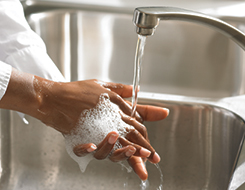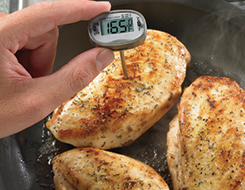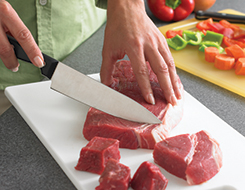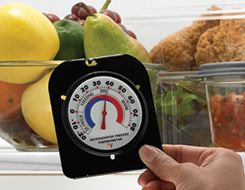4 Easy Lessons in Safe Food Handling
Food handling safety risks at home are more common than most people think. The four easy lessons of CLEAN, SEPARATE, COOK, and CHILL can help prevent harmful bacteria from making your family sick. To find out more about food safety, visit befoodsafe.org.

Clean.
Bacteria can spread throughout the kitchen and get on hands, cutting boards, knives, and countertops. Frequent cleaning can keep that from happening.
- Wash your hands with warm water and soap for 20 seconds before and after handling food.
- Wash cutting boards, dishes, utensils and counter tops with hot soapy water after preparing each food item and before you go on to the next food.
- Consider using paper towels to clean up kitchen surfaces. If you use cloth towels wash them often in the hot cycle of your washing machine.
- Rinse fresh fruits and vegetables under running tap water, including those with skins and rinds that are not eaten.
- Rub firm-skin fruits and vegetables under running tap water or scrub with a clean vegetable brush while rinsing with running tap water.

Cook.
Even for experienced cooks, the improper heating and preparation of food means bacteria can survive.
- Use a food thermometer to measure the internal temperature of cooked foods. Make sure that meat, poultry, egg dishes, casseroles and other foods are cooked to the internal temperature shown in the chart.
- Cook ground meat or ground poultry until it reaches a safe internal temperature. Color is not a reliable indicator of doneness.
- Cook eggs until the yolk and white are firm. Only use recipes in which eggs are cooked or heated thoroughly.
- Bring sauces, soups and gravy to a boil when reheating.

Separate.
Cross-contamination is how bacteria spreads. Keep raw meat, poultry, and seafood and their juices away from ready-to-eat foods.
- Use one cutting board for fresh produce and a separate one for raw meat, poultry and seafood.
- Separate raw meat, poultry, seafood and eggs from other foods in your grocery shopping cart, grocery bags and in your refrigerator.
- Never place cooked food on a plate that previously held raw meat, poultry, seafood or eggs.

Chill.
Bacteria spreads fastest at temperatures between 40 °F and 140 °F, so chilling food properly is one of the most effective ways to reduce the risk of foodborne illness.
- Chill leftovers and takeout foods within 2 hours. Keep the fridge at 40 °F or below and use an appliance thermometer to check the temperature.
- Refrigerate or freeze meat, poultry, eggs and other perishables as soon as you get them home from the store.
- Never defrost food at room temperature. Food must be kept at a safe temperature during thawing. There are three safe ways to defrost food: in the refrigerator, in cold water, and in the microwave. Food thawed in cold water or in the microwave should be cooked immediately.

